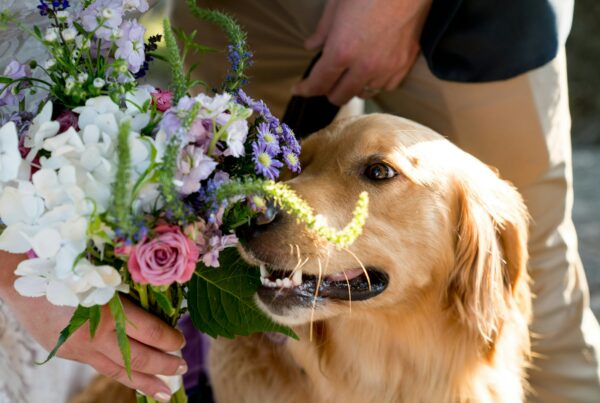By Aidan Bindoff on 01/01/2008
Filed in – Special Situations – Click to Calm: Healing the Aggressive Dog
Recognize your dog?
Do you have an excitable, active, or reactive dog? Does one or more of the following phrases describe your dog?
gets hyped up when you prepare for a walk
whines excitedly in the car
bowls over visitors in excitement
lunges or barks at other dogs on walks
gets frantic seeing other dogs playing or competing in sports
displays signs of separation anxiety
chases everything that moves
on walks, tows you like a truck
urinates submissively
can’t contain herself when you come home, even if you’ve only been gone long enough to take out the trash
attacks the vacuum cleaner
Wishful thinking
Wouldn’t it be great if your dog came with a big dial on his or her back that told you exactly how anxious, frightened, or excitable he or she was?
Wouldn’t it be great if your dog came with a big dial on his or her back that told you exactly how anxious, frightened, or excitable he or she was? Wouldn’t it be awesome if you could turn this dial and calm your dog?
Believe it or not, your dog does come with this “dial” and you can turn it back—with a little help from your clicker, of course.
Not on purpose, but…
Chances are these excited, anxious, or fearful behaviors have been reinforced. The truth is that it is very easy to reinforce these behaviors. You may even feel compelled to reinforce them, although that was never your intention.
Imagine a dog who whines excitedly in the car. You arrive at your destination and your dog is just-so-excited-to-be-here-and-bark-bark-desperate-to-get-out-and-run-around-whine-whine-whine. There is nothing worse than sitting in a car with a dog who is whining to get out, so what do you do? You let your dog out of the car and…
…you have just reinforced whining! What’s more, your dog has just reinforced you for letting him out sooner rather than later.
Another example of automatic, unintentional reinforcement is the dog who bowls over visitors. What does the visitor do?
“Oh, you’re a big puppy! How about you hop down?” [push]
“HOP DOWN!” [wave hands in dog’s face]
Wouldn’t you love that response if you were a big, boisterous, and non-verbal Labrador retriever looking for attention?
The Calm-O-Meter solution
Let’s look at a third example and a possible solution. A dog (we’ll call her “Sabella” but she bears no resemblance to an actual German shepherd by that name), gets overly excited when she is about to embark on her nightly walk. Her owner, an enlightened trainer, has her sit and wait patiently at the door until she calms down. He does this because he knows that letting her out the door in her excited state will only reinforce that excited state for future walks—and will probably result in temporarily forgotten leash manners and reactive aggression towards other dogs as well.
But how does Sabella’s owner know when she is calm enough to be let through the door?
He could look for certain signs: rate of breathing, ear and tail carriage, whining frequency and volume, pupil dilation or contraction. But that’s a bit complicated. All he really needs to do is ask himself, “On a scale of 1-10, where 1 is very calm and 10 is very excited, how calm is Sabella right now?” He’ll get a reasonably accurate answer, something good enough to work with.
Simple, huh? This is called using the “Calm-O-Meter.”
Just as you can reinforce excited behaviors, you can reinforce calm behaviors.
Turn the dial, but where to stop?
Next is to “turn back the dial” on that Calm-O-Meter. Just as you can reinforce excited behaviors, you can reinforce calm behaviors. But, keep in mind that it would be unreasonable to ask a dog to go from grade 10 “hyper” to grade 1 “comatose.” That would set the dog up to fail and leave nothing to reinforce.
Instead, figure out what grade the dog is at when she sits, then ask for one grade less. If your Sabella is consistently at a grade 7, wait until she calms down to grade 6, then click and open the door. If Sabella is consistently at grade 6, wait until she has calmed down to grade 5, then click and open the door.
The Calm-O-Meter can be a metric for clicker training, using successive approximations toward the goal—a calm dog. Calm could be at grade 3 or 4; Sabella shouldn’t have to lose her zest for life completely! If you aim too low, she might not ever make it out the door.
Historical borrowing
The Calm-O-Meter idea isn’t completely new. Like so many other techniques in dog training, it is an idea borrowed from human clinical psychology, modified and repackaged. The human clinical psychology equivalent is the SUDs scale, which stands for Subjective Units of Distress/Disturbance/Discomfort Scale. Of course dogs cannot be asked their level of stress or calm directly, but most dog owners are sufficiently in tune with their dogs for this technique to give fairly reliable results.
Useful for the trainer
If you are a dog trainer, you may need to coach your clients on how to read and calibrate their own dogs’ scales. The Calm-O-Meter system could also help teach your clients what is reasonable behavior from their dogs. Many times people just get used to certain behaviors and only look for help when those behaviors become unbearable. The Calm-O-Meter provides a way to re-measure or re-assess a client’s awareness of certain behaviors, at the same time helping set reasonable expectations for what is asked of the dog while those behaviors are changed.
Let us know!
Try the Calm-O-Meter, see what you think, and then add your comments to the bottom of this article. We love feedback! We would particularly love to know if you use this technique in conjunction with the Click to Calm protocols.
This article was reposted by New York Dog Nanny.


